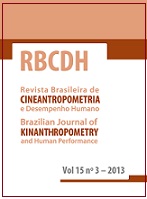Influência da dor no controle postural de mulheres com dor cervical
DOI:
https://doi.org/10.1590/1980-0037.2013v15n3p371Resumo
O objetivo foi verificar a influência da dor no controle postural de mulheres com dor cervicale a relação com as possíveis alterações nos sistemas sensoriais e postura corporal.O grupo dor cervical foi composto por mulheres, entre 20 e 50 anos, com dor cervicalpor mais de três meses e o grupo controle por 20 mulheres sem dor cervical. Para caracterização, utilizaram-se anamnese, índice de incapacidade cervical e Escala Visual Analógica. O equilíbrio postural foi avaliado por uma plataformade força. O equilíbrio com manipulação dos sistemas sensoriais foi avaliado pela posturografia dinâmica Foam-laser, expondo o indivíduo a seis testes de organização sensorial. A postura foi avaliada pelo Software de Avaliação Postural. Normalidade das variáveis verificada pelo teste de Shapiro Wilk etestes t de Student e Mann Whitney para comparação entre grupos, nível de significânciade 5%. Os grupos apresentaram homogeneidade nas variáveis demográficas. No equilíbrio postural, observou-se maior amplitude e velocidade de deslocamento do centro de pressão no grupo dor cervical, demonstrando maior oscilação postural. Houve diferença significativa no ângulo crâniovertebral, mostrando anteriorização da cabeça nas mulheres sintomáticas. Na posturografia dinâmica,observou-se diferença entre os grupos sendo que o escore obtido nas seiscondições sensoriais demonstrou que o grupo dor cervical apresentou maior comprometimento do equilíbrio. Dor cervical e postura anteriorizada da cabeçatêm efeito deletério no controle postural de mulheres sintomáticas, tanto na postura estática quanto na postura dinâmica.
Downloads
Publicado
Edição
Seção
Licença

Direitos Autorais para artigos publicados nesta revista são do autor, com direitos de primeira publicação para a revista. Em virtude da aparecerem nesta revista de acesso público, os artigos são de uso gratuito, com atribuições próprias, em aplicações educacionais e não-comerciais, desde que seja dada a atribuição. Esta obra foi licenciada com uma Licença Creative Commons Atribuição 4.0 Internacional - CC BY


